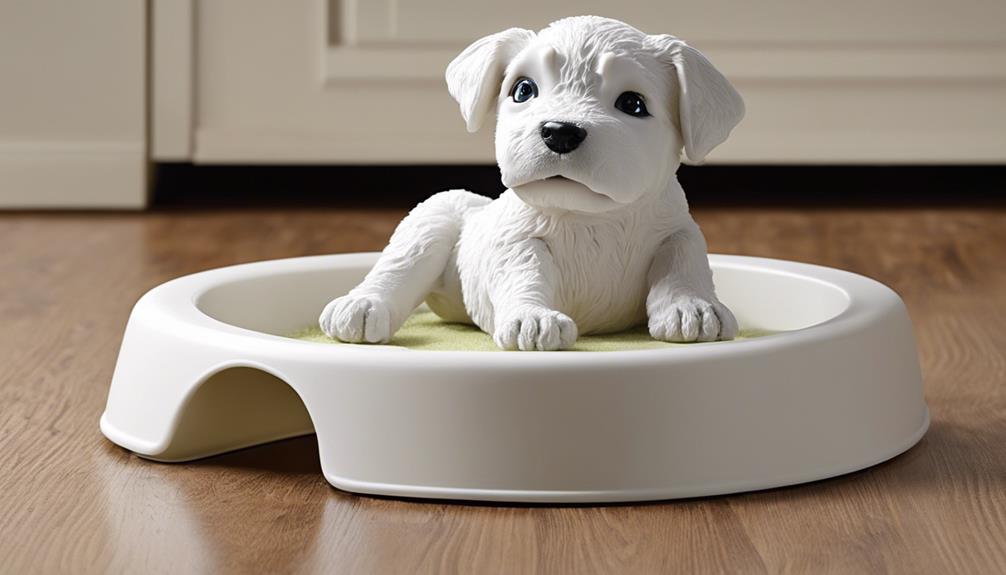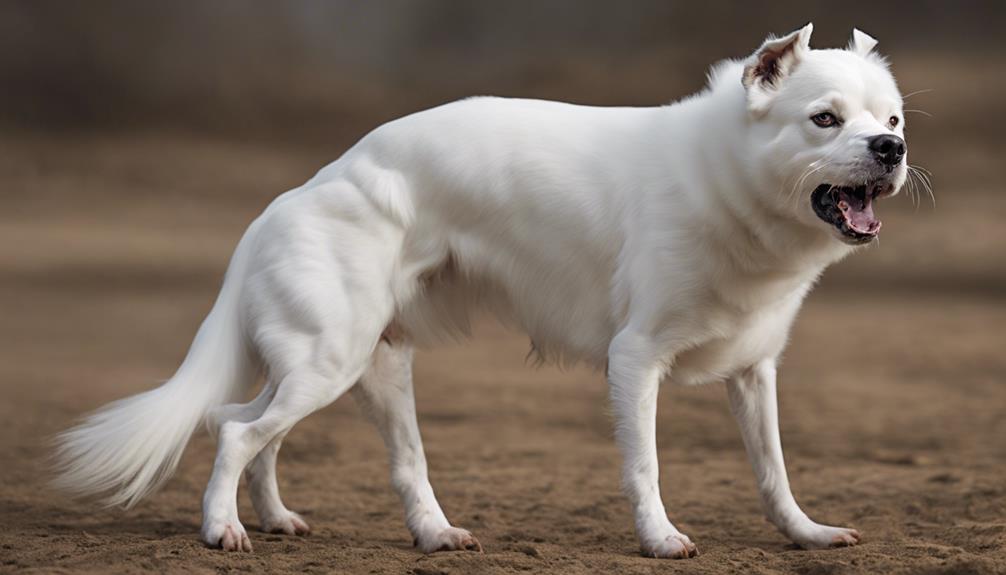Navigating the challenge of potty training a blind and deaf puppy is like embarking on a journey through uncharted territory. With our furry companions relying on different senses to navigate the world, understanding their needs becomes paramount.
Imagine the intricacies involved in communicating with a puppy that cannot see or hear, and the patience required to guide them through this essential training process.
As we explore the nuances of mastering potty training for these special puppies, we uncover a world of innovative techniques and strategies designed to pave the way for success.
Key Takeaways
- Tailor training techniques to accommodate sensory challenges
- Establish a structured routine aligned with meal and bedtime breaks
- Utilize positive reinforcement and tactile cues for effective communication
- Seek professional guidance for tailored solutions and environmental adaptations
Understanding Your Puppy's Needs
Understanding the needs of a blind and deaf puppy is essential for successful potty training. Training a puppy that's both deaf and blind requires a unique approach that considers their reliance on touch and smell. Traditional training methods may not be as effective, so it's crucial to adapt techniques to cater to their specific challenges. Providing a safe and consistent environment is paramount for these puppies to feel secure during the training process.
When potty training a blind and deaf puppy, consistency is key. Establishing routines and using positive reinforcement can go a long way in helping them understand what's expected of them. Patience is essential, as these puppies might take longer to grasp commands. Observing their body language and responses is vital in tailoring the training to meet their individual needs effectively. By being attentive and understanding towards their unique circumstances, we can create a successful potty training experience for blind and deaf puppies.
Establishing a Routine
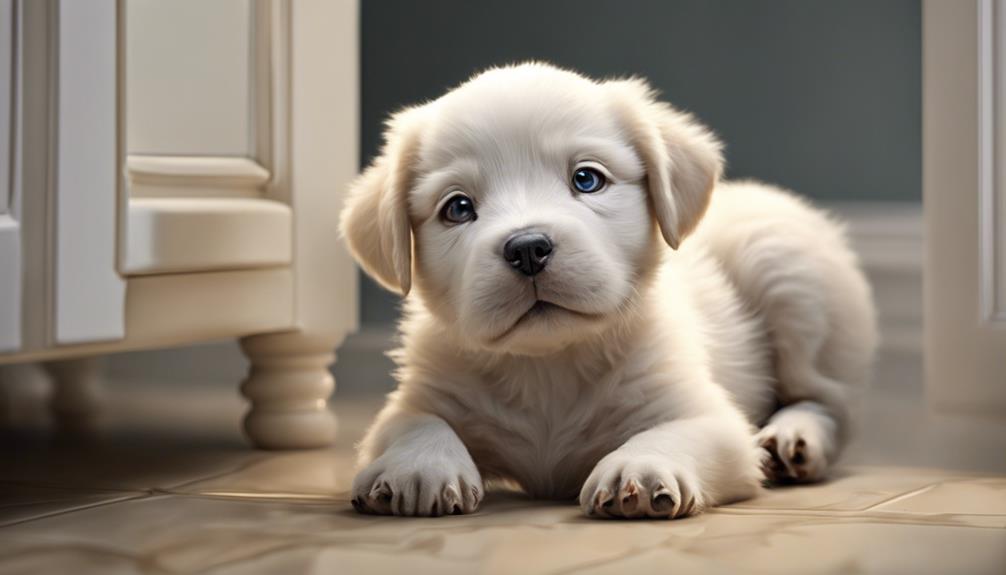
To successfully potty train a blind and deaf puppy, establishing a consistent routine tailored to their unique needs is crucial. Understanding the challenges these puppies face, we can create a routine that sets them up for success.
Here are some key points to consider:
- Meal-Based Schedule: Align potty breaks with the puppy's meal times and age to establish a predictable routine.
- Tactile Guidance: Use specific textured mats or flooring to help the puppy find the designated potty area easily.
- Bedtime Routine: Include a final potty break before bedtime to minimize accidents during the night.
- Verbal or Vibrational Cues: Implement cues like gentle vibrations or specific commands to communicate the potty area location effectively.
- Behavior Monitoring: Watch closely for signs indicating the puppy needs to go potty and adjust the routine as needed to reinforce good habits.
Using Scent Markers
Scent markers play a crucial role in guiding blind and deaf puppies to their designated potty area. Using scents like vanilla or lavender can help create a consistent signal for the puppy to associate with pottying. Dogs heavily rely on scent cues to navigate their surroundings, making scent markers a powerful tool for potty training blind and deaf dogs. Consistency is key when using scent markers; it helps reinforce the connection between the specific scent and the potty area for the puppy.
| Scent Marker | Purpose |
|---|---|
| Vanilla | Signals designated potty area |
| Lavender | Encourages elimination behavior |
| Citrus | Marks specific spot for pottying |
Implementing Touch Cues
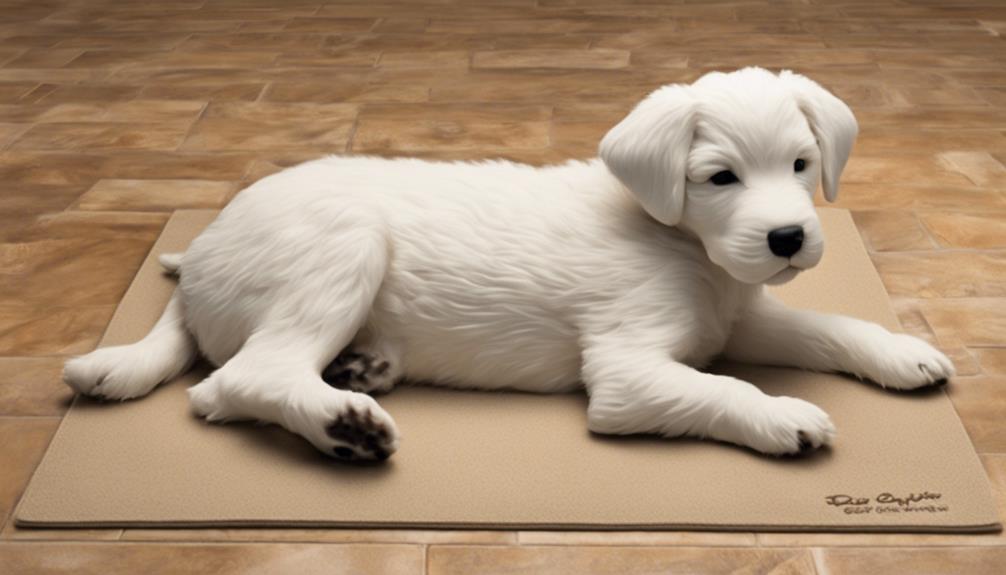
When implementing touch cues for a blind and deaf puppy, we rely on tactile training techniques to guide them effectively. These sensory cues play a crucial role in the puppy's learning process and understanding of where to go potty.
Consistent touch signals help establish a clear connection between actions and desired behaviors, making the training more successful for our special pup.
Tactile Training Techniques
Using gentle touch signals is crucial for guiding your blind and deaf puppy during potty training sessions and reinforcing positive behaviors. Incorporating tactile training techniques allows you to help your puppy navigate and understand commands through physical contact. Consistent touch cues will assist your puppy in comprehending what's expected during training sessions. By implementing touch cues effectively, you can establish a strong bond and communication channel with your furry companion.
Here are some key points to remember:
- Utilize different types of touch cues to convey various commands effectively.
- Be patient and gentle when using touch signals to avoid causing any distress.
- Use consistent touch cues paired with verbal cues to reinforce learning.
- Reward your puppy with treats or praise when they respond correctly to touch cues.
- Practice touch cues regularly to enhance your puppy's understanding and responsiveness.
Sensory Cues for Learning
To facilitate effective communication and bonding with your blind and deaf puppy, incorporating sensory cues like gentle taps and hand signals is essential during potty training sessions.
These tactile cues serve as a means of guiding your puppy towards the designated potty area. By using consistent touch cues, such as placing their paw on a specific textured surface to indicate the potty spot, you help them understand the desired behavior.
Positive reinforcement techniques can be integrated alongside these touch signals to reinforce the connection between the cue and the desired potty behavior. As your puppy becomes more accustomed to the routine, you can gradually phase out the touch cues, allowing them to rely more on memory and scent cues.
Consistent Touch Signals
Navigating the world of potty training a blind and deaf puppy requires a deep understanding of how to effectively implement consistent touch signals. When training deaf puppies, touch signals become their primary mode of communication. Here are some key points to consider when incorporating touch cues into your training routine:
- Use gentle and clear touch cues to guide the puppy to the designated potty area.
- Implementing touch cues helps the puppy understand specific commands and expectations.
- Touch signals provide tactile feedback for the puppy to navigate and learn appropriate potty behaviors.
- Consistency in using touch signals reinforces the training process and aids in the puppy's understanding.
- Regularly practice and reinforce touch signals to ensure the puppy grasps the intended communication effectively.
Crate Training Benefits
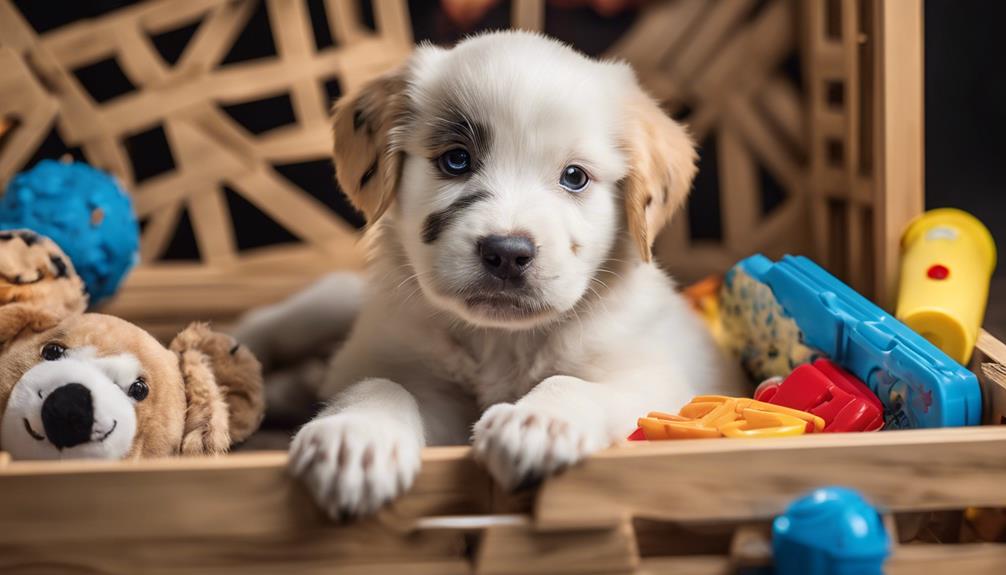
Crate training offers a safe and secure space for a blind and deaf puppy to rest and relax, aiding in establishing a routine for potty training and promoting good habits. By providing a designated area for the puppy to rest, crates become a comforting space that can help reduce anxiety and stress, especially for a puppy with sensory impairments. Limiting the puppy's access to the house through crate training can also assist in preventing accidents inside, fostering good potty habits as they learn to associate the crate with relaxation and sleep rather than a place to relieve themselves.
Moreover, crates serve as a valuable tool in managing the puppy's behavior and ensuring their safety when unsupervised. They create a den-like environment that appeals to a dog's natural instinct to seek out a cozy and secure space. This controlled environment not only aids in potty training but also helps in establishing boundaries and promoting good behavior as the puppy learns to respect their own space.
Positive Reinforcement Techniques
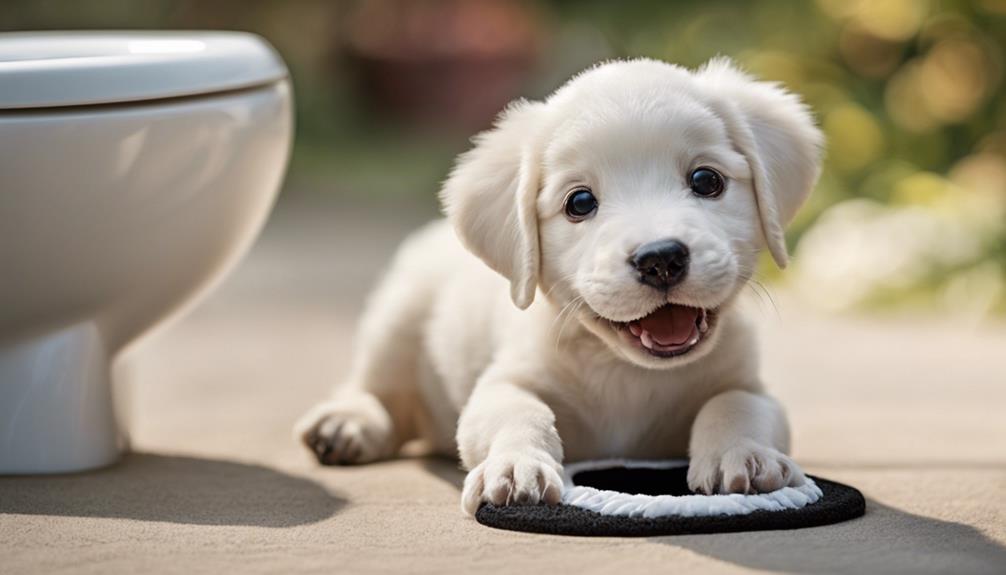
When potty training a blind and deaf puppy, utilizing positive reinforcement techniques is key to fostering successful bathroom habits. Positive reinforcement involves rewarding desired behaviors like using the designated potty area with treats, praise, or play to encourage potty training success. Celebrating each successful potty break with enthusiasm creates a positive association with the behavior in your special needs puppy.
Here are some tips for effectively using positive reinforcement with blind dogs:
- Consistently reward your blind and deaf puppy for using the designated potty area to reinforce the desired behavior.
- Celebrate each successful potty break with enthusiasm to encourage your puppy to repeat the behavior.
- Use a combination of treats, tactile cues, and affection to help your blind and deaf puppy understand the potty training process.
- Positive reinforcement techniques build trust, confidence, and a strong bond between you and your blind and deaf puppy.
- Be patient and consistent in your positive reinforcement efforts to help your puppy learn successful bathroom habits.
Consistency Is Key
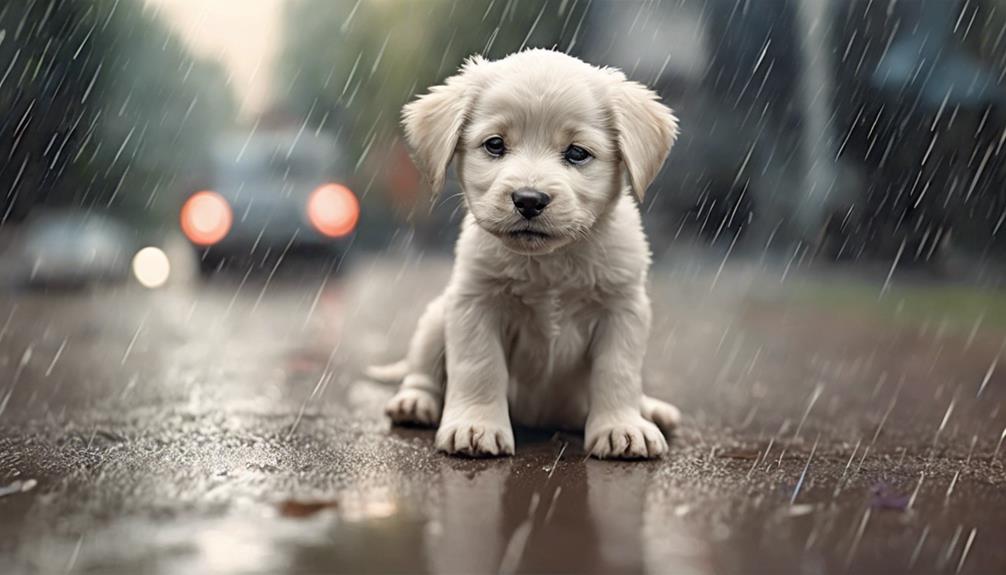
When it comes to potty training a blind and deaf puppy, consistency is crucial.
We need to stick to a routine, use clear communication methods, and employ positive reinforcement techniques.
These practices help the puppy understand what's expected of them and make the training process smoother and more effective.
Routine for Training
To establish a successful potty training routine for a blind and deaf puppy, consistency plays a crucial role in reinforcing positive behaviors. Here's a practical approach to creating a routine:
- Set Specific Break Times: Establish specific times for potty breaks to create predictability.
- Systematic Reinforcement: Use a systematic approach to consistently reinforce good potty behaviors.
- Structured Schedule: Create a structured schedule for feeding, water intake, and potty breaks to regulate the puppy's routine.
- Training Timing: Consistency in the timing of training sessions helps the puppy anticipate potty opportunities.
- Repetition and Predictability: Repetition and predictability in the routine are essential for successful potty training.
Clear Communication Methods
Establishing consistent hand signals and tactile cues is paramount for effectively communicating with a blind and deaf puppy during potty training. Incorporating verbal cues might seem natural, but for a puppy with sensory impairments, tactile cues play a vital role. Here's a handy table to guide you through the key communication methods:
| Communication Method | Description | Example |
|---|---|---|
| Hand Signals | Use specific gestures for commands | Thumbs up for "good job" |
| Tactile Cues | Employ touch commands for guidance | Light taps to indicate direction |
| Scent Cues | Introduce scents to mark potty areas | Lavender scent for potty spot |
| Routine | Establish a consistent schedule for toilet breaks | Regular potty times for training success |
Positive Reinforcement Techniques
Using consistent positive reinforcement techniques is essential for successfully potty training a blind and deaf puppy. Rewarding desired behaviors with treats or affection helps reinforce good potty habits. Consistency in using the same cues and rewards aids the puppy in associating them with pottying correctly. Positive reinforcement not only promotes good behavior but also builds trust and strengthens the bond between the puppy and the owner.
To ensure effective potty training, consider the following Training Tips:
- Reward the puppy immediately after they potty in the designated area.
- Use a consistent reward system to reinforce desired behavior.
- Employ verbal cues or tactile signals to guide the puppy during potty time.
- Celebrate and praise the puppy enthusiastically when they potty correctly.
- Be patient and persistent in your positive reinforcement efforts.
Utilizing Tactile Surfaces
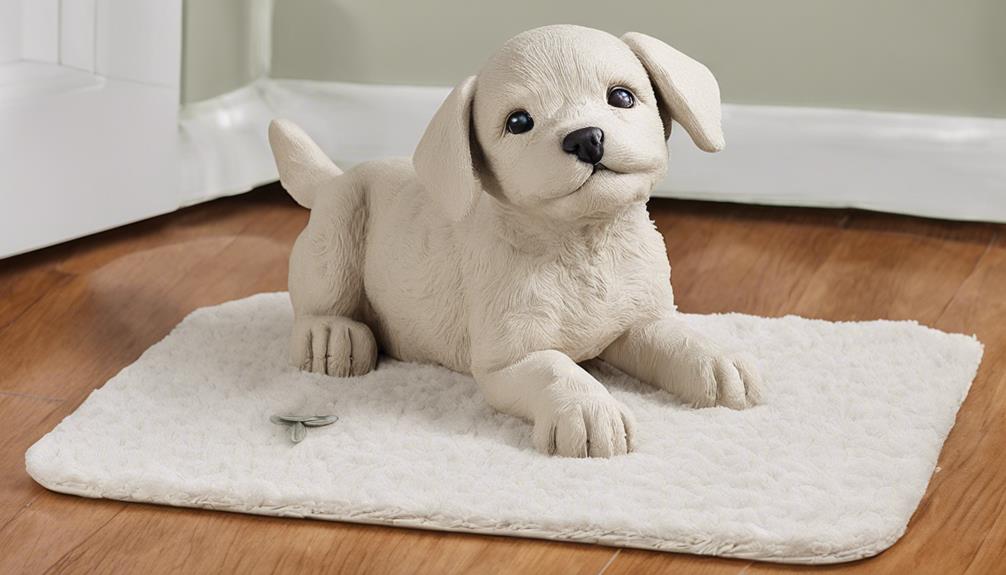
When training blind and deaf puppies, incorporating tactile surfaces such as natural pee pads is essential for providing texture cues that guide them effectively to the designated potty area. These surfaces offer a unique way for our special pups to understand where they should go potty.
The texture of these pee pads helps them distinguish the potty area from the rest of the space, making it easier for them to navigate. By using natural pee pads with specific textures, we can reinforce positive potty behaviors in our blind and deaf furry friends.
Tactile surfaces play a crucial role in helping these puppies find their way and feel more confident in their environment. By incorporating tactile surfaces into their potty training routine, we enhance their sensory experience and facilitate a more successful learning process.
Managing Indoor Accidents
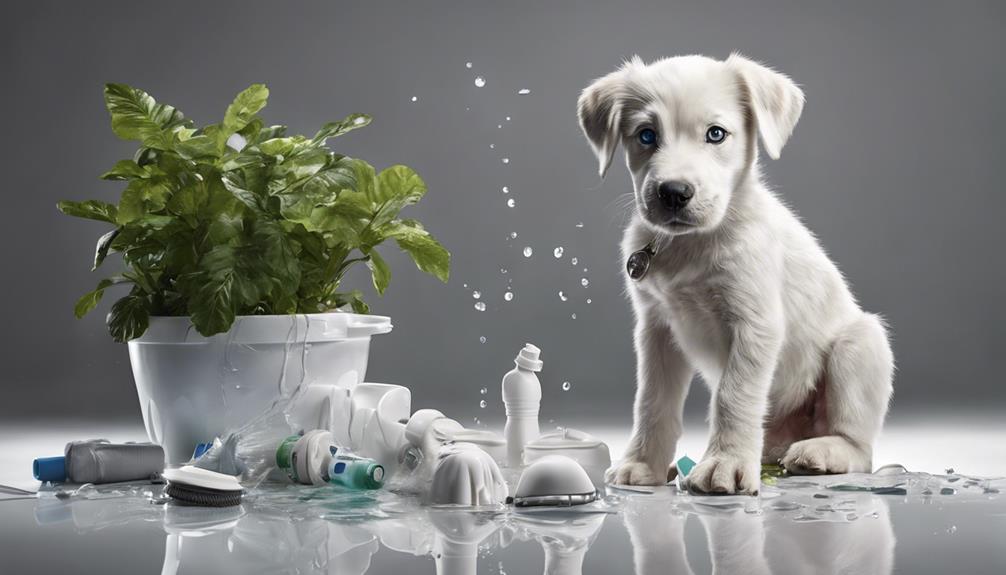
Navigating indoor accidents can be a challenging aspect of potty training for blind and deaf puppies, requiring proactive measures to address and prevent them effectively. When our dog finds accidents indoors, it's crucial to handle them with care and consideration.
Here are some strategies to help manage indoor accidents:
- Use enzymatic cleaners: These cleaners are essential for effectively removing indoor accident odors, preventing re-marking, and maintaining a clean environment.
- Supervise closely: By keeping a close eye on your puppy, you can catch accidents in real-time and redirect them to appropriate potty areas promptly.
- Establish a consistent schedule: Implementing a regular feeding and potty schedule can help minimize indoor accidents by creating a routine for your puppy to follow.
- Consider temporary solutions: Indoor grass patches or natural pee pads can serve as temporary potty solutions, especially during the initial stages of potty training.
- Positive reinforcement: Provide positive reinforcement and gentle redirection when accidents occur to encourage the desired behavior and reinforce potty training efforts.
Monitoring Water and Food Intake
Let's focus on how closely following your puppy's water and food intake can help us predict their potty needs accurately.
By regulating their food portions, we can establish a routine that aligns with their bathroom requirements.
Ensuring a balanced diet and monitoring their water consumption will aid in scheduling potty breaks, especially during nighttime.
Hydration and Nutrition Tracking
Monitoring your blind and deaf puppy's water intake is crucial for accurately predicting their potty needs. It's essential to keep a close eye on their hydration and nutrition levels to establish a routine that works for their special needs.
Here are some tips to help you track their intake effectively:
- Use measuring cups or bowls to monitor food and water portions.
- Maintain a consistent feeding schedule to regulate bathroom breaks.
- Consider high-quality, easily digestible food to support your puppy's health.
- Keep a log of their intake and bathroom habits to identify patterns.
- Consult with your vet for personalized advice on your puppy's hydration and nutrition requirements.
Portion Control Strategies
Maintaining consistent portion control is essential for effectively monitoring your blind and deaf puppy's water and food intake to support their potty training routine. By carefully managing the amount of food and water your puppy consumes, you can better predict when they'll need to relieve themselves, aiding in successful potty training.
Monitoring water intake is crucial, especially before bedtime, to reduce nighttime accidents. Adjusting food portions according to your puppy's size, breed, and individual needs is key to regulating their bathroom schedule.
Balanced Diet Essentials
Ensuring a well-balanced diet for your blind and deaf puppy involves closely monitoring their water and food intake to support their potty training routine effectively. Observing the following guidelines can aid in maintaining a healthy diet and successful potty training for your furry friend:
- Monitor Water Intake: Keep an eye on how much water your puppy drinks to regulate potty breaks.
- Control Food Intake: Managing food portions helps predict when your puppy needs to go potty.
- Hydration is Key: Ensure your puppy stays hydrated for overall health and digestion, impacting their potty routine.
- Food and Water Patterns: Observing intake patterns helps set your dog's potty training schedule.
- Consistent Diet: A balanced diet leads to consistent potty habits.
Good job setting your dog up for success with a well-monitored diet!
Seeking Professional Guidance
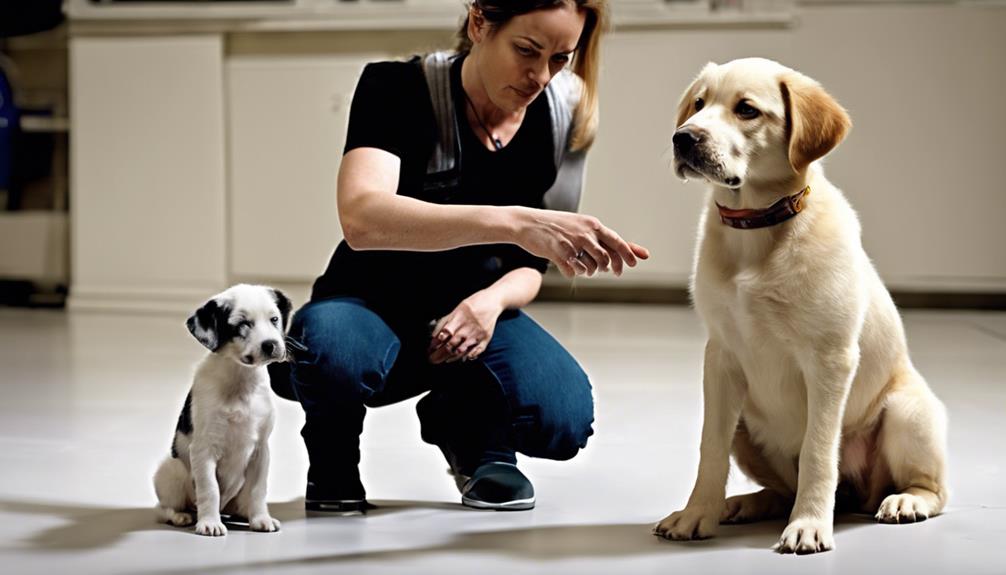
When seeking professional guidance for potty training a blind and deaf puppy, consider reaching out to experienced trainers for tailored solutions and specialized techniques. These experts can offer valuable insights into creating a safe and supportive environment for effective training. They understand the unique challenges faced when training a deaf pup and can help modify methods to suit their heightened sense of smell. Working with professionals ensures a structured approach to potty training that takes into account the sensory needs of your special furry companion.
| Benefits of Seeking Professional Guidance |
|---|
| Tailored solutions for unique challenges |
| Specialized techniques for effective training |
| Support in creating a safe training environment |
| Modification of methods for sensory needs |
Seeking professional guidance for potty training your blind and deaf puppy can make a significant difference in the success of the training program. Experts can provide innovative solutions that cater to your puppy's specific needs, ensuring a positive and effective learning experience.
Frequently Asked Questions
Can You Train a Blind and Deaf Puppy?
Yes, we can train a blind and deaf puppy. It requires unique techniques, like using tactile cues and scents.
Patience and positive reinforcement are crucial. Understanding the puppy's needs is key.
Seeking advice from experienced trainers helps. With dedication, we can successfully train a blind and deaf puppy.
Is It Harder to Potty Train a Deaf Dog?
Oh, is it harder to potty train a deaf dog? Absolutely! Visual cues are key, but consistency is our best friend. Positive reinforcement keeps the tail wagging in the right direction.
Understanding their needs is crucial; it's a bit like learning a new language! With patience and practice, we can tackle this challenge together.
Let's guide our deaf pups with love and understanding towards potty training success.
Can You Potty Train a Blind Dog?
Yes, we can potty train a blind dog using scent cues and texture guidance. Natural pee pads like Bark Potty help by providing essential texture cues.
Scents, such as treat scents or pet-safe oils, assist blind dogs in locating appropriate potty areas. Placing unlit candles strategically can also guide blind dogs to the designated spot.
Textural cues play a vital role in helping blind dogs navigate effectively to find the potty area.
How Do You Take Care of a Blind and Deaf Puppy?
We believe in providing a nurturing environment for blind and deaf puppies, focusing on touch cues, consistent routines, and positive reinforcement.
Creating a safe space with scents and textures helps them navigate. Seeking advice from experienced trainers can address specific challenges.
Our approach aims to reduce stress and anxiety, promoting a happy and healthy life for these special pups.
Can Deaf Dog Training Classes Help with Potty Training a Blind and Deaf Puppy?
Yes, deaf dog training classes can definitely help with potty training a blind and deaf puppy. These classes are specifically designed to cater to the unique needs of deaf dogs, so they can be a great resource for teaching your blind and deaf puppy how to navigate and communicate in their environment.
Conclusion
We've learned that blind and deaf puppies require unique strategies for potty training.
Did you know that 95% of blind and deaf puppies can successfully master potty training with the right techniques and support?
By understanding their needs, establishing a routine, and using sensory cues, we can help our furry friends succeed.
With patience, consistency, and a positive attitude, we can create a happy and healthy environment for our special puppies.

